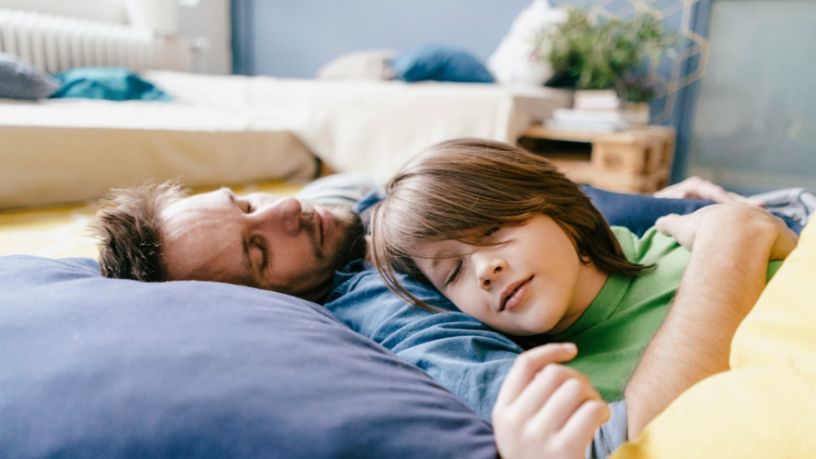Wanting to stay up late and sleep in are actually a normal part of a teenager’s development.
Key takeaways
Digital devices might be disrupting your teen’s sleep.
Get expert tips for setting boundaries around your child’s sleep schedule.
As a parent of little ones, you dream of the day when the kids will sleep in. But be careful what you wish for.
Adolescence is a sudden and often challenging battle to (among other things) get your kids out of bed and off to school.
Professor Harriet Hiscock, paediatrician and Group Leader of Health Services at Murdoch Children's Research Institute, has been researching sleep problems in childhood and adolescence for 2 decades.
She says the age-old problem of teenagers wanting to stay up late and sleep in is a natural phenomenon that’s often exacerbated by technology, social media or anxiety.
“Things like social media and online games at night all compound the shift in sleep cycles,” Professor Hiscock says. “And it’s not compatible with getting up and going to school in the morning.”
Here, we look at some common sleep challenges and their potential solutions.
The biological change
While it may be frustrating for parents to get a tired teen out of bed after they’ve been up late at night, it’s important to realise that the staying up part is actually normal for this age group.
During adolescence, our circadian rhythms (internal body clocks) change, telling us to go to bed later than normal and wake up even later.1
“It’s a normal part of development,” says Professor Hiscock. “There’s a shift in adolescence where melatonin [the chemical our bodies produce to make us feel sleepy at night] is produced later.”
Professor Hiscock says this change generally starts at around 12 to 13 years of age, and tends to peak in the mid-adolescent years.
“We don’t really have a good explanation for why this happens, it’s just a natural shift in melatonin,” she says.
It's an immense time of development [in] both their brains and bodies. Some adolescents will want to sleep a lot longer than usual, particularly if they're going through a growth spurt.
The solution
It can be hard to fight nature. However, Professor Hiscock recommends sitting down and planning out an agreed bed schedule with your child.
“That might include a time for lights out, making sure the phone is out of the room and homework is done,” she says.
“But if, biologically, they’re just not ready, you can’t just say go to sleep at 8, 9 or 10pm,” Professor Hiscock adds. “Try being tolerant of later bedtimes as long as they can wake up in the morning.”
Because sunlight switches off melatonin,2 Professor Hiscock suggests opening up your child’s blinds or curtains in the evening. This way, light will enter their bedroom the next morning, helping them naturally wake.
She also suggests having your child sit up in bed in the morning rather than laying in and hitting the snooze button.
“And if [they’re] going to sleep in on weekends, try not to make that more than an hour past their normal wake-up time,” she adds. “If they sleep until midday on the weekends, it’s harder to get up 8am on weekdays.”
Technology and social media
Social media can impact your sleep in many ways.
First, the blue light emitted from devices can suppress your release of melatonin, affecting the length and quality of your sleep.3
Moreover, scrolling through social media before bedtime can overstimulate you. And if you don’t have notifications silenced, the constant pings or light can disrupt your sleep.4
In fact, one UK study found that teenagers who spent 3 or more hours a day on social media were more likely to stay up late and have disrupted sleep patterns.5
“If your smartphone is [keeping you up], you won’t get enough sleep to function during the day,” says Professor Hiscock. “Then you get grumpy, want to sleep in, and your parents are battling to get you up in the morning and ready for school. It’s a bitter cycle.”
The solution
Professor Hiscock recommends creating clear boundaries from the start, when your child first gets a device.
“Set up an agreement about device use in the evenings from the very beginning. By the time they get to 16 or 17, trying to set new rules is a lot harder.”
Some boundaries may include:
- setting times of the day to look at devices
- an agreed ‘switch off’ time every day
- keeping devices outside of the bedroom (that’s good for adults too!)
- no devices at meal times.
Professor Hiscock also recommends using the American Academy of Paediatrics’ online tool to create a ‘Family Media Plan’, which can be personalised and aligned to age-specific guidelines.
“Look at those guidelines as a family and decide how they could be applied in your household. Agree to some rules and stick them on the fridge. Importantly, mum and dad have to abide by it as well.”
Anxiety
According to a 2019 report from the Australian Institute of Family Studies, adolescents who don’t get enough sleep are more likely to display symptoms of anxiety and depression and less likely to be happy.6
Professor Hiscock says the impact of mental health on sleep is under-recognised.
“Teens might stave off the anxiety during the day because they are doing things and their mind is otherwise occupied, but when they turn off the light at night, they lay in bed worrying.”
According to Professor Hiscock, symptoms of anxiety and depression are sometimes obvious. But other times, teens might appear simply grumpy or irritable, and it may take longer to find the root of the problem.
The solution
If you’re worried that your child is anxious at bedtime, Professor Hiscock advises against asking them about it just before they sleep.
“Try making time after school or on the weekend to talk and listen to them and let them know it’s normal to feel worried at times,” she says. “Ask what is worrying them. How it’s going at school, with teachers, at work or with their friends.”
It can also help to problem solve together with your child.
“As parents, we tend to want to come up with all the solutions, but teenagers need to come up with the answers themselves,” says Professor Hiscock.
“You may uncover the child has a learning issue at school, or perhaps there’s a problem in their friendship group. Once you pinpoint the cause, it’s about brainstorming some practical tips to work on the problem together.”
As young people approach their final years of high school, study stress might affect their sleep.7
“Sometimes teenagers need some help planning if they are getting overwhelmed by all the academic demands,” says Professor Hiscock. “A visual planner like a whiteboard may help them to break their workload down into manageable chunks.”
It's also important to ensure they have time to go out with friends, play sport or music or do other things they enjoy. Study can't be their complete focus.
Things like yoga, meditation and even owning a dog can also help alleviate anxiety.
Professor Hiscock also suggests looking into online, evidence-based cognitive behavioural therapy (CBT) programs like BRAVE or THIS WAY UP, or seeking out support from a psychologist.
If your child has ongoing sleep trouble, a paediatrician can rule out any medical causes of sleep problems and look at some behavioural interventions or medications if necessary.
Resources
To help limit devices in the home, create an American Academy of Paediatrics Family Media Plan.
BRAVE offers evidence-based support for kids and teens to help them learn about stress and anxiety.
THIS WAY UP provides clinically backed mental health tools and resources, including programs related to sleep.

At Bupa, trust is everything
Our health and wellbeing information is regularly reviewed and maintained by a team of healthcare experts, to ensure its relevancy and accuracy. Everyone's health journey is unique and health outcomes vary from person to person.
This content is not a replacement for personalised and specific medical, healthcare, or other professional advice. If you have concerns about your health, see your doctor or other health professional.
1Carskadon, M. A. (2011). Sleep in adolescents: the perfect storm. Pediatric clinics of North America, 58(3), 637-647.
2Mead, M. N. (2008). Benefits of sunlight: a bright spot for human health. Environmental health perspectives, 116(4), A160-A167.
3Silvani, M. I., Werder, R., & Perret, C. (2022). The influence of blue light on sleep, performance and wellbeing in young adults: A systematic review. Frontiers in Physiology, 13, 943108.
4Cleveland Institute. (2022). Why You Should Ditch Your Phone Before Bed. Cleveland Institute.
5BMJ Open. (2019). 3+ hours daily social media use linked to poor sleep patterns in UK teens. [News release]. BMJ Group.
6Evans-Whipp, T., & Gasser, C. (2019). Are children and adolescents getting enough sleep?. Australian Institute of Family Studies. LSAC Annual Statistical Report 2018, chapter 4.
7Landers, K., & Buckley, P. (2023). The problem that can create a vicious cycle for high school students. SBS News.
You might also like...
How important is sleep?
Making sure you have a good night's sleep is one of the best things you can do for your health and wellbeing.
Eco Anxiety: How to help kids manage it
Our world is being affected by climate change, and so is the mental health of our kids. So how can you help them if they experience eco-anxiety?
How to have conversations with kids
It’s like the flick of a switch. Suddenly, your little chatterbox doesn’t want to talk to you anymore. So, what can you do to help your child open up again?
How to talk to your kids about social media
Social media is a daily part of our kids’ lives, whether we like it or not. So, what are the risks and benefits, and how can we keep our kids safe online?





